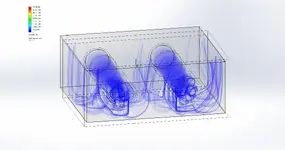rosej3570
Jr. Member
- Joined
- May 26, 2016
- Messages
- 41
- Reaction score
- 68
- Golden Thread
- 0
- Location
- Le Claire, IA
- Primary Interest:
- All Treasure Hunting
- #21
Thread Owner
I got a CFD analysis started on the Bazooka-ish Gold Trap. I did 3/32" holes, spaced 1/4" apart, one set down, the next at 45 degrees to the sides, then down again. I ran a lot of simulations and only had a couple vortex's begin. I will run more analysis when I have time. I also have a video, but I have to figure out how to upload it. I wonder if putting in a wedge on the bottom of the bed may help drive vortex's to catch finer gold. I will try it sometime and see.


Last edited:




